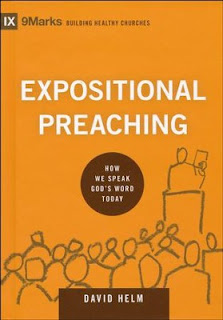Featured
- Get link
- X
- Other Apps
Book Review: Expository Preaching
David Helm earned his MDiv from Gordon-Conwell
Theological Seminary and serves as Senior Pastor of Christ Church in Chicago,
Illinois. Additionally, he holds the position of Chairman of the Board at Charles
Simeon Trust, an organization focused on training pastors and teachers to
communicate the Bible. He is also a Council member of the Gospel Coalition. Helm’s
extensive experience in preaching informs his book Expository Preaching.
Thesis and Content
Helm’s thesis is succinctly stated: “Expositional
preaching is empowered preaching that rightly submits the shape and emphasis of
the sermon to the shape and emphasis of a biblical text” (13). He articulates and
supports this argument through four main sections. The first section focuses on
the art of contextualization. wherein Helm asserts that effective
contextualization involves conveying the data of the Bible to contemporary
audiences while maintaining message accuracy (40).
The second section places emphasis on exegesis.
“All preaching must begin with exegesis” (43). Exegesis encompasses
the historical and cultural context of the biblical text, including its
placement within the book or letter. Helm emphasizes that the sermon’s flow
should be guided by the inherent structure and sequence of the text rather than
trying to impose an artificial structure. The communicator’s job is not to
control the flow of the sermon, but rather to let the biblical text do the
work.
Section three engages with theological
reflection. Contextualization and exegesis are integral parts of the communicator’s
task of preaching. Preaching and teaching are both spiritual work, too. “…It is
a rigorous and prayerful discipline of taking the time to meditate on my text
and how it relates to God’s plan of redemption” (63). Theological reflection
should lead readers to find the gospel across every page of the Bible. A key
requirement of this is faith, biblical theology, and systematic theology. The
final section of the preparation process focuses on synthesis (89). Helm
emphasizes that blending these components requires three elements in mind: audience,
arrangement, and application.
Assessment
Helm’s book serves as a valuable resource for a
variety of readers. His accessible communication style is paired with
intellectual humility. The book is as practical as it is easy to understand.
Helm effectively unpacked the principles of expository preaching in easy-to-follow
steps. The inclusion of diagrams, helpful illustrations, and a pastoral tone provide
a replicable process. Moreover, Helm brings subjects like biblical theology and
systematic theology to a level accessible to the average Christian in the
congregation.
He also writes with the intention of growth, both
the reader and the church. His reflection questions serve not only to maintain
the reader’s engagement but also to facilitate practical application. Additionally,
Helm places significant focus on the application of sermonizing, an aspect
sometimes overlooked by communicators. The emphasis underscores the importance
of aligning preaching with transformative outcomes.
However, Helm’s work does have its limitations.
His work appears tailored to pastors in various church contexts, yet it lacks a
broader engagement with cultural diversity. Diversifying his illustrations and
incorporating interdisciplinary insights, such as rhetoric, communication
studies, or psychology, could enhance his connection to a wider Christian
context. Furthermore, Helm might be served well in exploring dialogical,
expository preaching practices.
In summary, Helm’s book is a helpful, refreshing read. He presents a compelling vision for expository preaching’s role in local churches. He also provides a working schema to produce an expository sermon. The book caters to both newcomers and experienced pastors, making it a commendable resource.
Popular Posts
What I Learned in my First Year: Prioritize Bible over Talking Points
- Get link
- X
- Other Apps
Proverb of the Day: 8/27/2024
- Get link
- X
- Other Apps

Comments
Post a Comment